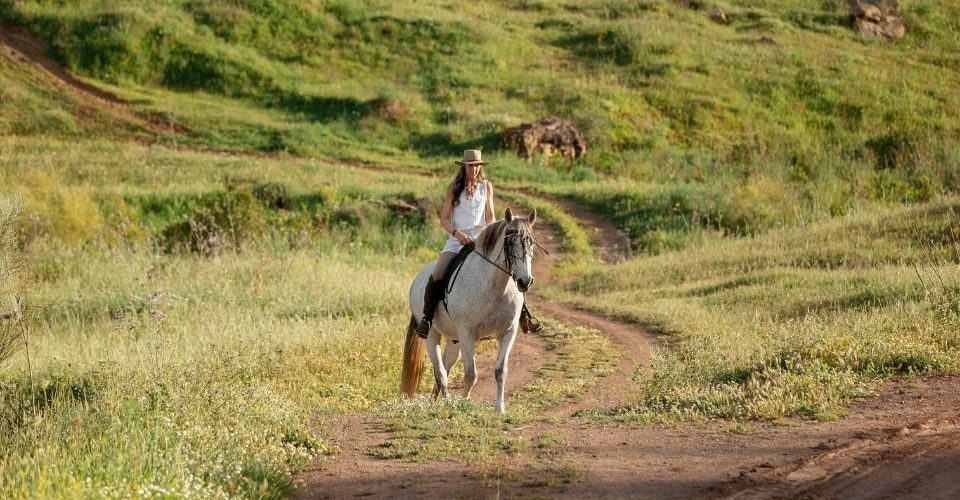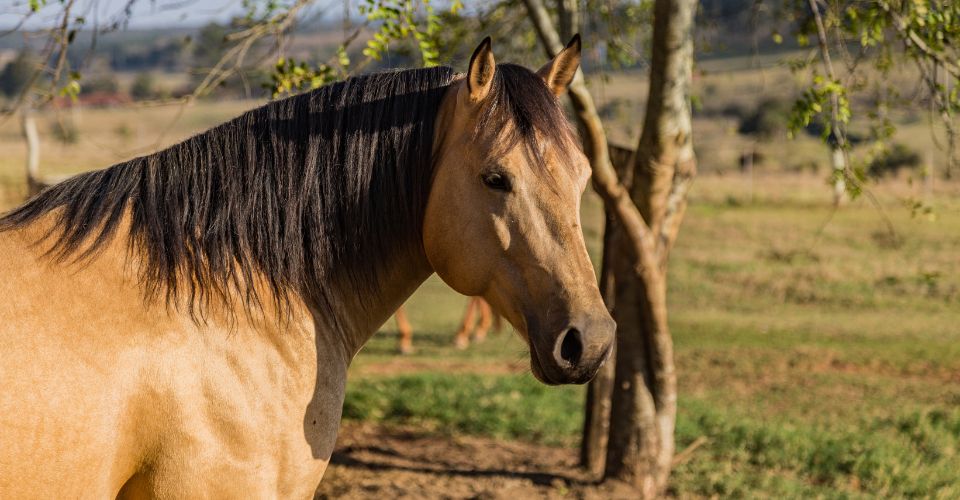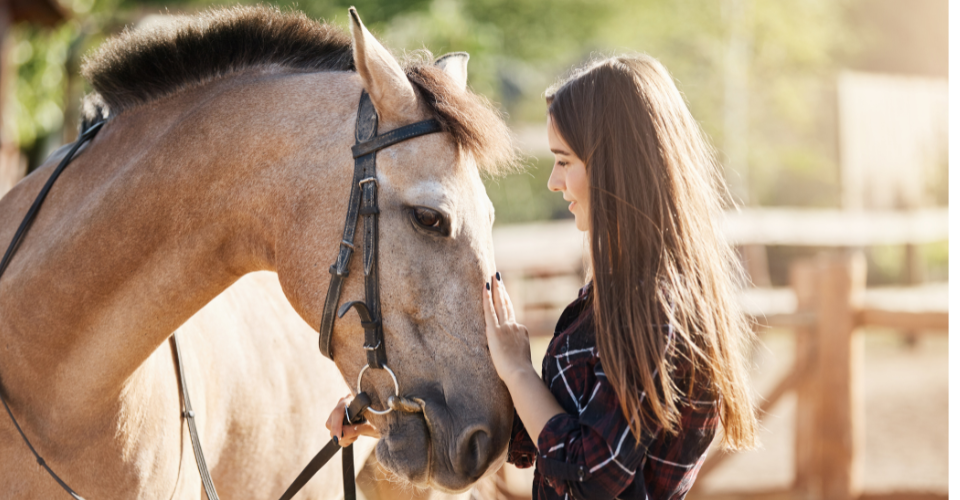That day we took our horse for trail-riding. After some time, we all got tired, but it didn’t, it was as fresh as a daisy. That made us wonder, how far can a horse travel in a day?
Research shows that if a horse has good stamina, it can travel 100 miles in a day. A regular trail horse that is in fine shape can travel 50 miles a day at a brisk walk with some water breaks and cool down a bit. A horse’s fitness level is an essential factor in finding out how far can a horse travel in a day. However, it is not the only factor that affects the range a horse can travel in a given time.
How Far Can a Horse Travel?
If your horse is adequately trained and equipped, it can travel thousands of miles. It is not recommended to push them too hard and make them run longer than they can, as it could result in long-term health problems or injuries.
Nan J. Aspinwall traveled from San Francisco to New York on horseback in the year 1911. The journey was 3,200 miles and 178 days long.
A horse on a one-day trip tends to travel faster than a horse traveling for prolonged periods—horses on one day of travel are able to complete 50 – 60 miles, or even more. In contrast, cavalry that is mounted on horseback for weeks tends to travel 20 – 30 miles a day. Horses may not withstand consecutive days of riding till it gets a day or two off.
Riding a horse at a run is the most exciting sensation. While a run or gallop, they can run around 1 – 2 miles without taking a break. Then again, horses trained for long-distance running can go a little longer. For short trips, galloping is a good option. However, for longer travels, try keeping your horse to a canter or trot.
How Far Can a Horse Travel in a Day?
As mentioned above, while trotting, cantering, or walking, a horse can travel up to 20 – 30 miles a day. It is suitable for long-distance travel, where campers and riders prefer slower paces to keep their horses going longer. Additionally, relaxed, well-hydrated, well-bred, and well-trained horses tend to go a little further than that.
For a more extended trip, try keeping the distance less than 20 miles at a time so that the total amount of distance reached can be maximized while still keeping your horse fit.
10 Factors Affecting the Speed and Distance of How Far Can a Horse Travel in a Day
Horses, like humans, vary from each other and perform differently, even if they are the same breed. Some may be ordinary, while some are quite extraordinary.
There are some aspects to consider for knowing how far a horse can travel. Some of them are:
1. Health & Fitness
Fitness is basically the general health and capability of a horse to be athletic. To be fit like a fiddle, a horse needs to have proper nutrition, exercise, and rest. A horse needs to be fit if it has to travel long distances, or else it could undergo an incurable injury. To keep your horse in shape, regular training is important.
Humans train in a different way for a marathon than they’d for a 100-yard dash. In the same way, horses are trained on the basis of travel distance. A horse’s capacity to exercise is increased by fitness training that helps boost its muscle endurance. Fitness training is a process that depends on the age and fitness level of the horse, some horses taking longer while others get trained easily.
Older horses might have a touch of arthritis and could possibly not be able to catch up with the speed you expect. They may perhaps be willing to keep up with their younger and fitter trail partners but can probably become lame after such an intense ride. Horses get active when they’re in a group and push themselves beyond their capabilities to keep up with the others.
It is the duty of the rider to ward off the horse from overexerting. Current or previous injuries should also be kept in mind while training your horse. If your horse is not familiar with regular training to build up his cardiovascular fitness, do not let it overexert itself on a trail riding venture. A worn-out horse is prone to injuries and stumbling.
Regular training keeps a horse healthy and fit, but some other uncontrollable factors affect the horse’s overall health.
Some fitness concerns can be equipoised by doing the following:
- Keep your pace moderate
- Make frequent stops
- Arrange necessary riding equipment
- Provide access to food and water
- Pay your vet a visit before a multi-day ride.
2. Preparing Your Horse for Distant Travel
Patience is the key here. Spend a few months on training your horse before taking him on a long ride. Don’t push your horse too fast, wait for it to get into peak condition, or else it will incur an injury and set back the training.
In the first month, start with training your horse thrice a week for 45 minutes a day. By the end of the month, your horse would easily trot for 45 minutes. Increase the intensity of the training as you reach the second month. By the end of the second month of training, your horse would be steadfast for a 25-mile ride. Increase or decrease the intensity and length of training exercise based on your evaluation and monitoring. Your assessment is vital since you do not want to overstress your horse. A back-off on training is way better than resulting in a lameness issue.
While you increase the intensity, pick up pace one day and include hills one week. Exert your horse at 8 mph for 7 miles, then monitor its recovery time. If your horse is in good shape, the heart rate should rise up to 180 – 200, and its pulse rate should drop to 60 beats per minute (bpm) within 10 minutes of post-exercise. Horses that have lower heart rates post-exertion tend to perform better on endurance rides.
3. Gait
A horse’s gait is basically the pattern of their leg movement in action, either trotting, walking, or cantering. Some horses have a smooth, proficient movement naturally, which helps them travel further and faster, burning less energy than horses with less efficient gait.
A smooth gait is also convenient for the rider, as they often coordinate movement with their mounts, which makes long-distance rides comfortable.
In the middle ages, horses were used by Knights to fight in battles. However, when the Knights had to travel long and extended stretches, they preferred a palfrey horse to ride. Those horses had a smooth gait; hence they were more suitable for long-distance rides.
4. Tack
When traveling long distances on horseback, a properly fitted tack is very important because an improperly fitted saddle can harm the muscles, tissues, and nerves of your horse. Also, you will not be at ease, as an ill-fitted tack is so uncomfortable that it will cut your trip short. So make sure the saddle fits the horse properly.
A long trail ride is definitely not the best time to try new products, so it’s better to use a saddle you’re acquainted with or the one you’ve been using while training. Furthermore, never overtighten your horse’s girth; frequently check it and loosen it during rests.
5. Water & Feed
Adequate nutrition, energy, and free access to water are essential for your horse during long, extended rides. That way it will complete the ride efficiently and recover quicker. Check the blood work pre-ride to make sure your horse does not lack any minerals.
During the ride, take frequent breaks, allow your horse to graze, and stay hydrated—else, it could go through severe injuries. If your horse’s appetite is lost and is overheating, you should definitely be worried. These symptoms show that your horse is exhausted or worse. You should stop riding immediately, dismount, and give it some water. Similarly, untie the saddle and all tack. Let your horse cool down and relax.
It is natural for your horse to heat up during the hot dry weather, so make sure it has access to enough water during the ride. Likewise for yourself!
6. Terrain
The terrain is a crucial factor for determining how far can a horse travel in a day. Distance covered on clear, flat ground is way more than that covered on a rough, hilly, or mountainous terrain.
The rough, steep surface has a direct impact on the limbs and cardiovascular system of your horse. The concession on the hooves and joints of your horse is more evident on hard rocky terrain. Deep mud or sand is also ruinous for the tendons and ligaments of your horse’s legs. So, you need to take extra care and scale down the distance on such terrains and slow down your pace.
7. Suitable Equipment
Proper equipment is mandatory for you and your horse if you want to travel comfortably on long distances. Ill-fitted saddles can result in agonizing skin rubs and severe muscle issues. Tight or harsh brittle can also cause discomfort and pain. Improper shoes, loose or tight both can be an issue. Losing a shoe can be a good excuse for not covering the same distance that you may have.
Equipment, rather proper equipment, is necessary to curtail the risk of injury and cutting your trip short.
It could be a long way home if a Billet strap or a Latigo strap is broken in the middle of the ride on rocky terrain.
8. Weather Conditions
Weather is another important factor to consider in your long-distance ride with your equine friend. Like humans, horses also lose a lot of body water and electrolytes through sweat. If they exert too much and get dehydrated or deplete electrolytes, they can get heatstroke and suffer severe health crises.
During the long-distance rides, you need to give your horse frequent breaks and plenty of water in that hot humid weather when your horse is sweating like a pig. Whereas in hot, humid, and windy weather, when the sweat evaporates fast, they’re still losing water and electrolytes, so they still require the same care and attention. Allow them to drink freely throughout the journey.
Read: Can Horses Swim?
9. Rider’s Stamina
The stamina of the horse is essential, but it alone would not do it. A rider’s hardiness and physical capability are also important elements in deciding how far can a horse travel in a day.
Even skilled riders cannot stay in the saddle for the whole day, it’s painful and tiring for both. Your horse might be able to cover 25 miles, but you’d for sure call it off after 10.
If you, as a rider, are not a good leader, you’d be stuck in that puddle that your horse finds scary. Training and exercise are a must for both you and your horse—both should be fit and well-rested to have a great focus and clear mind your journey.
Don’t jump to long rides initially, rather take shorter and easier trails at first. Practice yourself and your horse, you’d be stunned how quickly you get saddle sore after a day ride.
10. Horse’s Pace
Knowing the horse’s pace will help to find out how far a horse can travel in a day and how much time it will take. At a certain pace, horses usually have an average speed per mile. They can go up to 4 miles per hour while walking, 8-12 miles per hour while trotting, 12-15 miles per hour while cantering, and 25-30 miles per hour while they gallop. However, gallop cannot be persistent, and the terrain might not allow it either.
How Far Can a Horse Travel at Peak Speed?
Although an average horse’s peak speed is around 30 mph, some exceptional horses that are strong, well-bred, and professionally trained to race or win endurance stretches like the Tevis Cup Race can get up to 45-50 mph at their peak speeds!
On the other hand, your horse might be able to run for about 5-8 minutes at its peak speed. For 5 minutes and 30 mph, your horse can run for 2.5 miles without a break. This distance is amazing for such a large animal to cover in such a less time.
However, you should not run your horse for longer periods without proper rest and hydration. Moreover, at a moderate pace (9 mph canter), your horse can cover the same distance in 25 minutes rather than 5. It’s a waste of time, but your horse will thank you later for not running them at full gallop.
One Day Trip vs. Back-to-Back Trips
Riders need to take into account the time period of the trip. A healthy horse can usually travel from 25 – 30 miles a day. These trips need to be at a slower pace with water breaks. A horse, however, cannot keep up with this pace for several days, as it will lead to health complications.
How Far Should You Ride a Horse?
Horses are expected to be long-term travel companions because they were built to be long-distance carriers of humans, either through pulling carts or through saddlebags that humans carried along.
At a lower pace, while walking, trotting, or cantering, a horse should be ridden around 20 miles a day at a time. Well-kept horses tend to travel a little longer if provided with rest, water, and feed.
On long trail rides, make sure to be well-prepared for the journey and protect yourself and your horse from potential dangers, i.e., dehydration, exhaustion, or injury.
Conclusion
The travel time of a horse depends on many factors. The travel distance of an average horse 100 years ago is different when measured up to that of an average today’s horse. Horse’s physical health and conditioning is the essential thing to consider.
It suffices to say that horses can travel around 15 to 20 miles a day if all these factors are taken into account. In perfect weather and geographical conditions, a horse can cover more than 30 miles in 24 hours, but that too is an extraordinary and rare case. Also, you and your horse should be properly equipped and conditioned. After this lengthy journey, he’d require several days’ rest.
| Explore: More Horse Products





